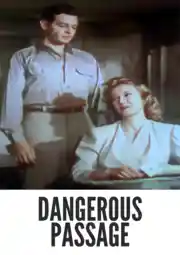Contact: [email protected]
Video Sources 0 Views
- Dangerous Passage Colorized


Dangerous Passage Colorized 1944: Best Noir Rediscovered in Colorized Old Movie
Synopsis
[ez-toc]
Introduction
In the realm of classic cinema, where shadows whisper tales of mystery and suspense, stands the timeless film noir “Dangerous Passage Colorized.” As we step into the world of this 1944 cinematic gem, we embark on a dual odyssey—one that traverses the moody monochromatic landscapes of old film classics and another that embraces the vibrant hues of modern colorization. This article delves into the colorized resurrection of “Dangerous Passage Colorized,” exploring the delicate dance between preserving the past and revitalizing it through the art of colorization.
Read Media File Transfer Agreement: Terms and Conditions
Read FAQ
Overview of “Dangerous Passage Colorized” as a Classic Film Noir
“Dangerous Passage” emerged from the shadows in 1944, marking its place in the annals of film history as a quintessential noir drama. Directed by William A. Berke, this cinematic masterpiece not only encapsulated the brooding atmosphere characteristic of film noir but also showcased Berke’s distinct contribution to the genre. Before we embark on the colorization journey, it’s essential to grasp the significance of “Dangerous Passage” in the broader context of film history.
The Significance of “Dangerous Passage Colorized” in Film History
A Noir Gem from 1944
“Dangerous Passage Colorized” wasn’t just a film; it was a window into the anxieties and complexities of its time. Against the backdrop of 1940s America, the film wove a narrative tapestry steeped in shadows, deception, and moral ambiguity—all hallmarks of the film noir genre. Director William A. Berke’s keen eye for noir aesthetics and storytelling prowess catapulted “Dangerous Passage” into the ranks of classics, where it remains a beacon of cinematic excellence.
Understanding the Art of Colorization for Old Films
Breathing Color into Shadows
The allure of classic black-and-white films often lies in their ability to evoke a certain timeless charm. Yet, the concept of colorization challenges this charm, offering a modern lens through which audiences can experience these cinematic treasures. The colorization process involves infusing color into a black-and-white canvas, a meticulous art form that navigates technological challenges to breathe vibrancy into monochrome masterpieces. Understanding this process is crucial as we explore how it was applied to “Dangerous Passage Colorized.”
Navigating Between Artistic Integrity and Modern Enhancement in Film Colorization
Balancing the Scales
Preserving the authenticity of original formats while enhancing the visual experience is a delicate tightrope walk in the realm of colorization. As we peer into the past through the lens of “Dangerous Passage,” we grapple with the fundamental question—does colorization compromise the artistic integrity of classic films, or does it open a gateway to a new era of cinematic appreciation? The delicate balance between the old and the modern is at the heart of this debate.
Examining the Colorization Process of “Dangerous Passage” and Its Results
The Artistry Unveiled
“Dangerous Passage” underwent a transformation, transcending its black-and-white origins to embrace the spectrum of colors. The specific colorization process employed, possibly on formats like NTSC DVD, shaped the film’s new identity. Our exploration peels back the layers, unveiling the nuances of the colorization journey and dissecting the results achieved in this cinematic rebirth.
The Debate: Should We Colorize Classic Films?
Clash of Perspectives
The debate surrounding the colorization of classic films echoes through the halls of cinephilia. On one side, proponents argue that revitalizing classics breathes new life into cinematic treasures, making them more accessible to contemporary audiences. On the other side, purists champion the cause of preserving the original black-and-white format, considering it a sacred relic of cinematic history. To colorize or not, that is the question—a question that reverberates through the film industry.
Appreciating “Dangerous Passage Colorized” in Both Black-and-White and Color Perspectives
A Dichotomy of Aesthetics
To truly appreciate the impact of colorization, we must embark on a comparative journey. How does “Dangerous Passage Colorized” differ when experienced in its original black-and-white form, shrouded in the noir atmosphere, and when bathed in the vibrant hues of color? This exploration unravels the dichotomy of aesthetics, allowing audiences to witness the film’s narrative through two distinct lenses.
The Enduring Legacy of “Dangerous Passage” in Its Colorized Revival
Echoes Through Time
As we navigate the critical reception of the colorized version of “Dangerous Passage,” we uncover the enduring legacy of this noir classic. How did audiences, both classic movie enthusiasts and modern viewers, respond to the colorized revival? The film’s impact and resonance form the pillars of its legacy, creating ripples that traverse time.
Embracing the Dual Aesthetics: Celebrating “Dangerous Passage” in Black-and-White and Color
A Cinematic Duet
In the final act, we arrive at a crossroads—a crossroads where the old meets the new, where shadows dance in monochrome and colors paint a vivid tapestry. “Dangerous Passage” stands as a testament to the dual aesthetics of classic cinema, inviting cinephiles to celebrate its legacy in both black-and-white and color. This cinematic duet allows audiences to savor the richness of an old film classic in a kaleidoscope of visual experiences.
Conclusion
Beyond Shadows and Colors
As the curtains fall on our exploration of “Dangerous Passage,” the journey through shadows and colors reveals a nuanced tapestry of cinematic history. The colorized revival of this noir classic beckons audiences to embrace the duality of aesthetics, to appreciate the film in both its original black-and-white splendor and the vibrant palette of modern colorization. In the end, “Dangerous Passage Colorized” isn’t just a film; it’s a bridge between eras, inviting us to navigate the timeless corridors of classic cinema with a fresh perspective.
















